Red-Y to Ride
Tips and advice for first-time riders.
Step 1: Get licensed
The requirements for obtaining your motorcycle operator’s licence typically involve a series of graduated steps before you’re able to ride any size of bike with no restrictions (such as staying off highways or not riding at night). Signing up for a certified rider-training course makes it easy to navigate through the process, and many may even provide the bike for you to learn on.
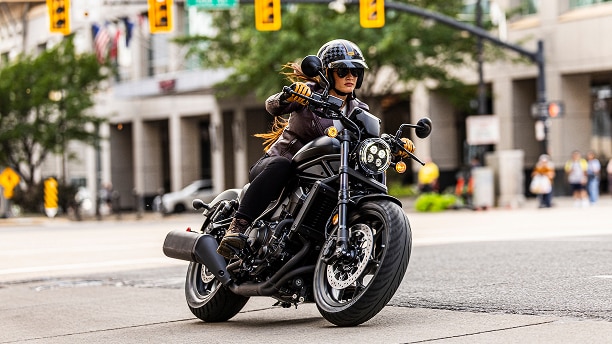
Step 1: Get licenced
The requirements for obtaining your motorcycle operator’s license typically involve a series of graduated steps before you’re able to ride any size of bike with no restrictions (such as staying off highways or not riding at night). Signing up for a certified rider-training course makes it easy to navigate through the process, and many may even provide the bike for you to learn on.
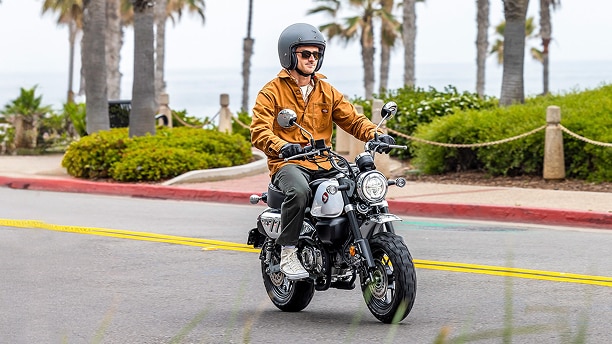
Find a Recommended Training School
Honda has selected some of the best training schools around to help you gain the skills and confidence required to successfully obtain your motorcycle license.
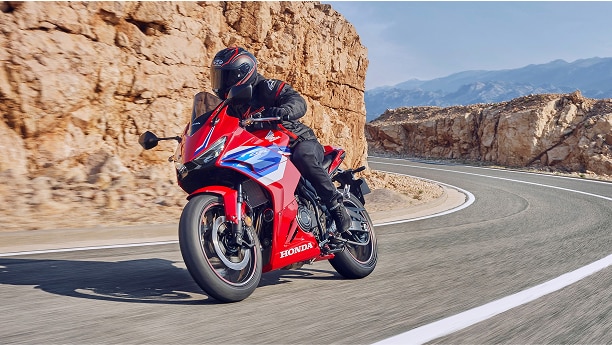
GET $200 OFF
Any Honda Motorcycle*
For a limited time, you can get $200 off a brand new, previously unregistered Honda Motorcycle after completing your rider-training course.
Offer expires 12 months after graduation.
Honda Canada reserves the right to cancel, change program at any time without notice. Contact your local Honda Motorcycle dealer or refer to legal disclaimer at the bottom of the page for full eligibility details.

Find a Honda Recommended Training School
Expand All
Alberta
British Columbia
Manitoba
New Brunswick
Newfoundland & Labrador
Nova Scotia
Northwest Territories
Not Available
Nunavut
Not Available
Ontario
Rider Training Institute (RTI)
College Boreal
Sault College
Canada Safety Council / Motorcyclecourse.com Kingston
Canada Safety Council / Motorcyclecourse.com Belleville
Canada Safety Council / Motorcyclecourse.com Lindsay
Canada Safety Council / Motorcyclecourse.com Oshawa
Canada Safety Council / Motorcyclecourse.com Ottawa
Canada Safety Council / Motorcyclecourse.com Pembroke
Canada Safety Council / Motorcyclecourse.com Peterborough
Learning Curves
Motorcycle Training Organization of Halton-Peel (MTOHP)
Ottawa Safety Council
Fanshawe College
Centennial College
Georgian College
Niagara College
Canadian Motorcycle Association
St. Clair College
Motorcycle Course
Ride Safe Motorcycle Training Inc.
Prince Edward Island
Not Available
Quebec
Tecnic Groupe Montréal
Tecnic Moto Mirabel
Tecnic Moto Montreal Ouest
Tecnic Lac St-Jean
Tecnic Alma
Tecnic Québec Metro
Tecnic Lévis
Tecnic Moto Québec
Tecnic Rive-Nord
Tecnic Blainville
Tecnic Joliette
Tecnic Galeries Laval
Tecnic Mascouche
Tecnic Repentigny
Tecnic Gatineau
Tecnic St-Eustache
Tecnic Ste-Thérèse
Tecnic St-Jérôme Nord
Tecnic St-Lin-Laurentides
Tecnic Ste-Agathe
Tecnic Shawinigan
Tecnic Trois-Rivières
Tecnic Rive-Sud
Tecnic Drummondville
Tecnic Sherbrooke
Tecnic Beloeil
Tecnic Châteauguay
Tecnic Granby
Tecnic Brossard
Tecnic Moto Desormaux (Longueuil)
Tecnic St-Hyacinthe
Tecnic Valleyfield
Tecnic Vaudreuil
Tecnic Haut Richelieu
Tecnic Cowansville
Tecnic St-Jean-sur-Richelieu
Tecnic Moto Montréal Centre-Est
Tecnic Plaza St-Hubert
Tecnic Haut du Lac
Tecnic Dolbeau-Mistassini
Tecnic Roberval
Tecnic St-Félicien
Tecnic Saguenay Centre
Tecnic L'Erable (Plessisville)
Tecnic Chibougamau
Tecnic Sept-Iles
Tecnic Nord-Ouest du Quebec
Tecnic Moto Mont-Laurier
Tecnic Abitibi-Témiscamingue
Tecnic Amos
Tecnic Val D’Or
Tecnic Côte Nord (Baie-Comeau)
Auto-École Steeve Duguay (Rivière-du-Loup)
Vachon École de conduite Supérieur (St-Georges)
Vachon École de conduite Supérieur (Sainte-Marie)
École de conduite À La Survie
École de Conduite Jasmil (St-Hyacinthe)
École de Conduite Lauzon (Repentigny)
École de Conduite MLB (Rouyn-Noranda)
École de Conduite Option (Longueuil)
École de Conduite Option (Delson)
École de Conduite Option (St-Jean-sur-Richelieu)
École de Conduite Option (Granby)
École de Conduite Permis Plus (Thedford Mines)
École de Conduite Permis Plus (St-Georges)
École de Conduite René Robitaille (Joliette)
École de Conduite St-Amour (Joliette)
École de Conduite Vision (Shawinigan)
École de Moto Centre-Ville (Québec)
École de Pilotage RDL (Rivière-du-Loup)
L'École de Moto Guyôme Blais (Lévis)
Moto École Barrette (Chicoutimi)
École de Conduite Première (Victoriaville )
École Pro Conduite (Saint-Constant)
École de conduite Auto Moto la Vallière (St-Filicien)
École de conduite Perry (Gaspé)
École de conduite Routec 132
École de conduite Lauzon Roubec
École de conduite ECCO
École de conduite (Baie-Comeau)
Mtl Moto Pro (Montréal)
École de conduite Mortys driving School (Montréal)
E C Moto Jean Pierre Chenu (Laval)
École de moto sur 2 roues (Sherbrooke)
École de conduite Maxi-Pro
École de conduite Perreault
École de Conduite Lotbinière
École de conduite NDR
Saskatchewan
Yukon
Not Available
Step 2: Choose your bike & gear
Riding a motorcycle is a whole lot of fun, and so is shopping for your first bike. Sure, it can seem overwhelming at first, with so many different models to choose from, but once you learn a little bit about how one style of bike differs from another, it’ll be easy to find the bike that’s just right for you. Here are a few of the important things to look for in your first bike:

Seat height
Being able to put both of your feet flat on the ground when you come to a stop gives you extra control and confidence. And if the seat is too high, the bike can feel intimidating to ride – particularly if you are just learning. Street bikes typically have a lower seat height than off-road or dual-sport bikes, in part because they need less ground clearance.

Seating position
A bike’s ergonomics – how your arms and legs are positioned and the angle of your back and neck when you’re riding – plays a huge role in ride comfort, how easy the bike is to handle and how confident you feel. The seating position may seem just right at a standstill, but awkward once you start riding. For your first bike, look for something that puts you in a gentle crouch – not too leaned forward with too much stress on your arms - and not too leaned back with your feet too forward.
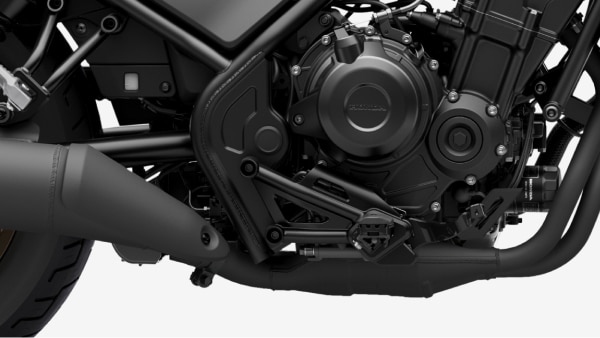
Weight
A lighter bike is simply easier to keep balanced when you’re stopped, or when you’re tip-toeing into a tight parking spot. It’s also easier to move around in a garage or put it on or take it off its sidestand or centrestand. In most cases, the bigger the engine, the heavier the bike. Honda weights always include a full tank of gas, so you know exactly the weight of the bike at its heaviest.
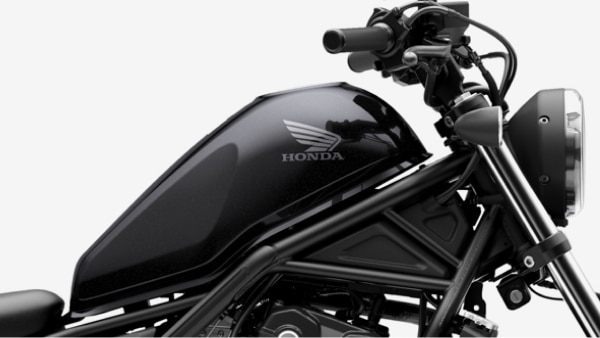
Bodywork Style
Unique style that showcases different looks for your bike from athletic, to sporty & retro. Designed to reduce air drag & fuel consumption and protect engine components.
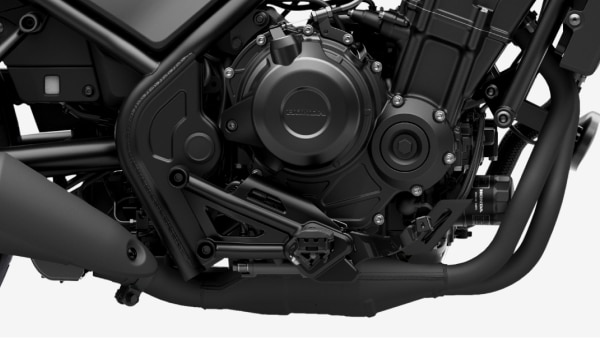
Engine Size
Along with displacement, the number of cylinders an engine has contributes to how it performs, how it feels, how it sounds, how much it weighs – even how it looks. Smaller bikes aimed at new riders typically have one or two cylinders to keep weight low and the bike narrow. Cruisers usually have two-cylinder engines, often with a classic V-twin shape, and high-performance sport bikes and touring bikes almost always have four, or even six, cylinders. Riders often fall in love with the sound and feel of a particular type of engine – all are capable of great performance, so it often comes down to what you prefer.
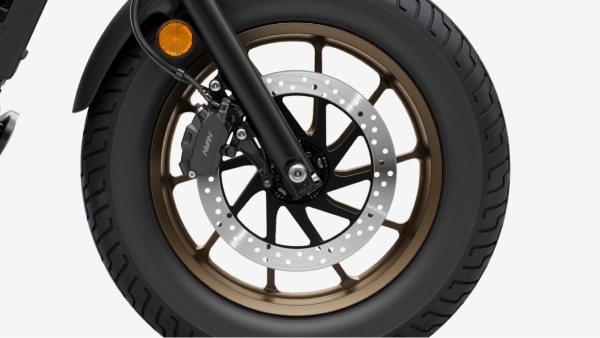
Brakes
Braking on a motorcycle is a lot like braking on a bicycle – it takes a little bit of practice to do it properly and safely without skidding the tires. That’s why Honda leads the way with technology designed to make braking a whole lot easier to master and safer to use. Especially when you’re just starting out, a bike with ABS (Anti-lock Braking System) is a great choice because ABS helps to prevent the wheels from locking and skidding if you brake too hard or on a slippery surface. An ABS system that links or combines the front and rear brakes is even better – it automatically applies some braking force to the front wheel when the rear-brake pedal is applied, and (depending on the type of linked system) some force to the rear wheel when the front-brake lever is applied.
Choose your bike style
We know the importance of getting a safe, confident, enjoyable start in the sport, which is why Honda offers one of the largest selections of bikes designed with novice riders in mind. Here’s a look at the six basic styles of bike and what they offer.
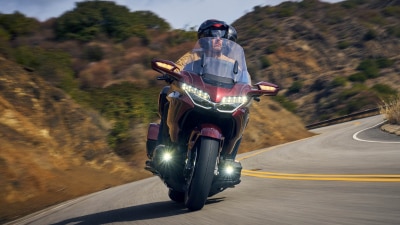
Touring
If you love to explore far-away places, a touring bike is the perfect companion. Features include extra protection from a larger fairing, a taller windshield, and plenty of options for carrying your gear.
Three Reasons You’ll Love a Honda Touring Bike:
- Smooth and powerful engine for comfort on all-day highway trips
- Ample fuel capacity to ride longer
- Built-in saddlebags, or bodywork designed to accept accessory bags
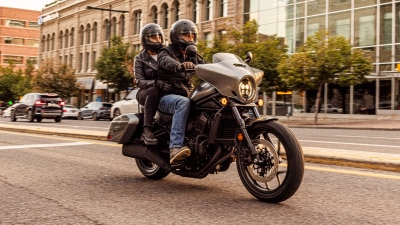
Cruiser
Featuring the look, sound and riding position like no other style of motorcycle, Honda offers a range of cruisers with different engine configurations for all types of riding and all types of riders.
Three Reasons You’ll Love a Honda Cruiser:
- High-tech features and light and compact design
- Excellent fuel efficiency to help you ride far and wide between fill-ups.
- Comfortable riding position that is relaxed and neutral
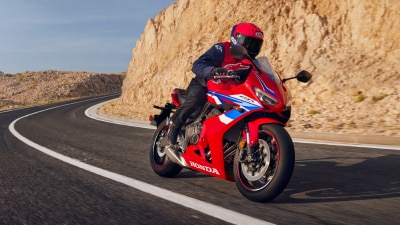
Sport
Sport bikes are perhaps the most exhilarating style of all motorcycles. They’re designed to go, stop, turn and handle with the utmost efficacy. Because of this, a smaller sport bike makes great sense as a novice rider’s first motorcycle.
Three Reasons You’ll Love a Honda Sport Bike:
- Available in a range of sizes
- Light weight for increased bike performance
- Optimum seat position for operating controls
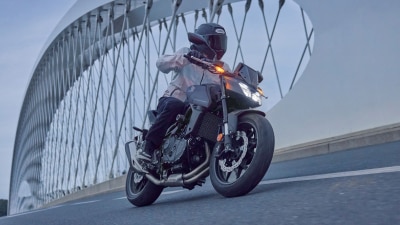
Standard
Standard bikes offer a blend of style and comfort, catering to riders of all levels with their user-friendly features and range of sizes. Their adaptable designs provide open and relaxed seating positions, ensuring versatility and contentment for riders.
Three Reasons You’ll Love a Honda Standard Bike:
- Available assist slipper clutch on most models
- Available in a range of sizes
- Light weight for better performance and control
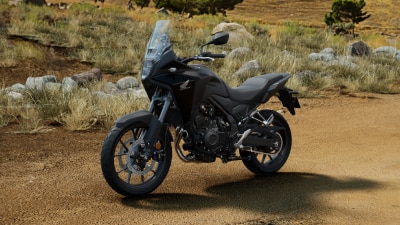
Adventure
No other style of motorcycle opens the door to freedom and new experiences quite like an adventure bike. If you’re a new rider unsure of where you want to go, an adventure bike leaves your options open.
Three Reasons You’ll Love a Honda Adventure Motorcycle:
- More ground clearance, suspension travel, special tires and more
- Higher handlebar and taller windshield for a clearer view
- The iconic performance that lets you explore like never before.
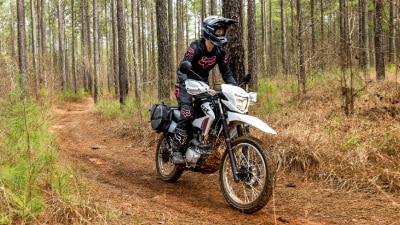
Dual Sport
From exploring remote regions to carving through city streets, every ride is a new adventure. Honda dual-sport motorcycles are designed for the best of both worlds, with ruggedly comfortable performance and impressive all-terrain capability.
Three Reasons You’ll Love a Honda Dual Sport Bike:
- Excellent on-road and off-road riding comfort and capability
- Powerful, lightweight performance to tackle any terrain
- Balanced dual-sport suspension and durable chassis design
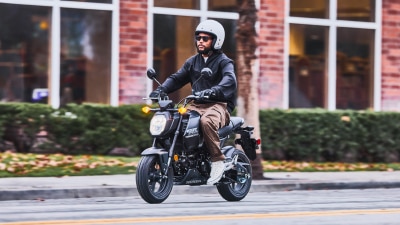
miniMOTO
Going to work or school or running errands sometimes can be a drag—but add one of these pocket-sized Hondas to the equation, and suddenly it becomes the best part of your day. Wherever you need to go, get ready to put a smile on your face. One ride on a Honda miniMOTO and you’ll be a fan for life!
Three Reasons You’ll Love a Honda miniMOTO Bike:
- A variety of styling options from Sporty, Modern & Retro
- Lightweight ride that offers incredible fuel efficiency
- So much fun to ride you’ll forget how practical it is
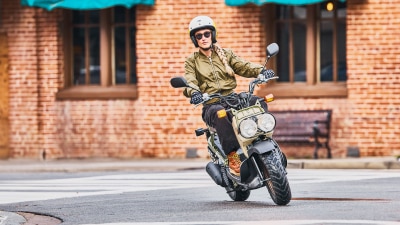
Scooter
Getting around just got a lot more fun! Getting from Point A to Point B transforms into an adventure when you do it on a Honda Scooter. Brighten your day and spark joy wherever you need to go! Scooters are reliable performers that offer comfort, control, and confidence.
Three Reasons You’ll Love a Honda Scooter:
- Scooters are ideal for city life
- Fun to ride, practical, and fuel efficient – the total package!
- Squeeze into tight spaces
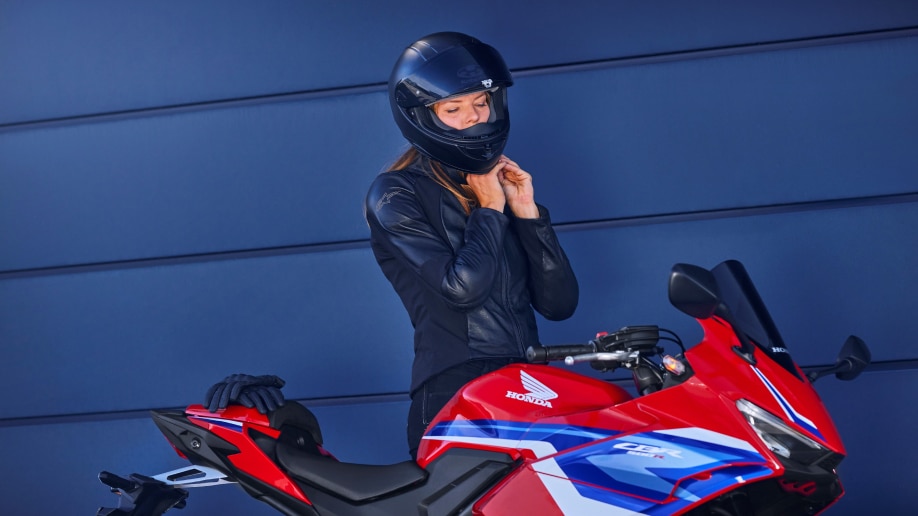
Choose your gear
Quality gear keeps you more comfortable during a ride, and acts as your suit of armour during falls and nasty weather. Whether you're going on-road or off-road, your local Honda dealership has it all, with the expertise to make sure everything fits right.

On-Road
The most comprehensive
level of protection
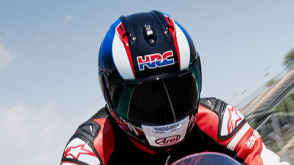
Helmet
Your helmet is the most important piece of protection. It must fasten securely and bear DOT and/or Snell approval. Full-face helmets are recommended over open face styles for improved comfort and protection.
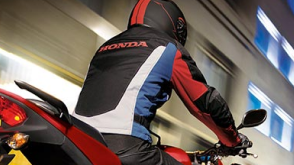
Jacket
Jackets provide excellent protection and act as a first line of defence in a fall. Make sure your jacket allows for correct adjustment. Textile or mesh offer increased practicality but leather offers the best protection.
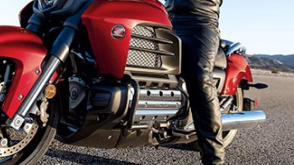
Pants
In a fall your knees, hips or legs are often first to contact the ground. Your pants can protect these areas from impact and abrasion. Make sure your pants include padding on the hips.
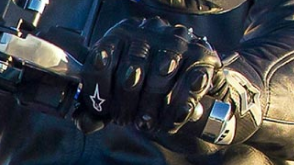
Gloves
A good pair of riding gloves not only helps protect your hands but also helps keep them from getting sore, tired or cold. They should fit snugly without causing discomfort. Leather construction with a plastic knuckle is best.
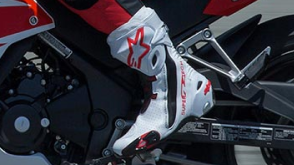
Boots
Quality footwear with good ankle protection is a must. Some boots can be quite dangerous because of the sole. Make sure yours do not have deep grooves that can hang up on the pegs easily. Boots with plastic panels are recommended because they tend to slide, rather than tumble when hitting the pavement.
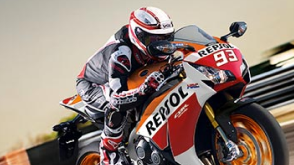
Suit
The most abrasion and impact protection possible is available only with the use of a well armoured, one-piece leather suit. Correct fit is more important than anything. All armour should fit snuggly in place and the leather should not move freely or fold over your skin.
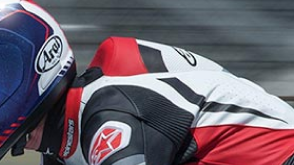
Spine protector
Most jackets and suits come with a supplemental spine pad, but these offer a minimal amount of spine protection. CE rated spine protectors improve the level of protection as well as cover a larger portion of the back. Your CE rated spine protector should be fully adjustable at the waist and shoulders to maximize safety.
Dual Sport
The most comprehensive
level of protection
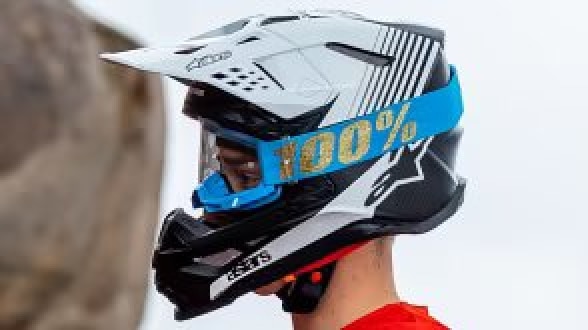
Helmet
Your helmet is without question the most important piece of protection. It must fasten securely, and bear DOT, and/or Snell approval labels. Full-face helmets are recommended over openface styles for their improved protection.
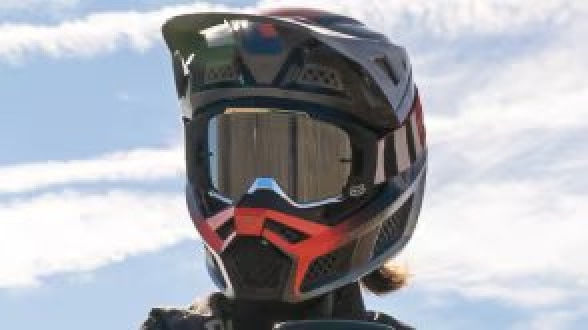
Goggles
Protecting your eyes is just as important as protecting your noggin, so goggles are a must when heading out on the trail. Make sure they fit inside your helmet opening and opt for higher-quality models with a foam seal and shatterproof clear or tinted Lexan® lense.
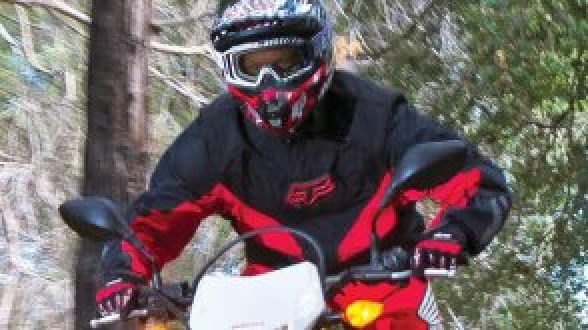
Jersery
Long-sleeved jerseys provide excellent protection from scrapes and cuts, and they keep a rider comfortable over a wide range of weather conditions. Most riding jerseys are made of materials that breathes well and stretches with normal body movements.
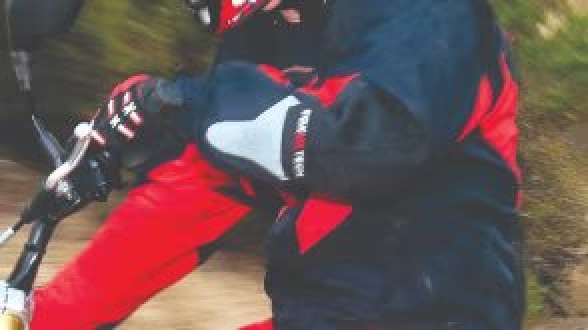
Elbow Guards
Further protection for your elbows and forearms comes in the form of hard-plastic, foam-lined elbow pads, worn underneath your jersey. These come in specific child and adult sizes, so make sure they fit snugly and won’t slip in the event of a fall.

Boots
Quality footwear with good ankle protection is a must. Some boots can be quite dangerous because of the sole. Make sure yours do not have deep grooves that can hang up on the pegs easily. Boots with plastic panels are recommended because they tend to slide, rather than tumble when hitting the pavement.

Suit
The most abrasion and impact protection possible is available only with the use of a well armoured, one-piece leather suit. Correct fit is more important than anything. All armour should fit snuggly in place and the leather should not move freely or fold over your skin.

Spine protector
Most jackets and suits come with a supplemental spine pad, but these offer a minimal amount of spine protection. CE rated spine protectors improve the level of protection as well as cover a larger portion of the back. Your CE rated spine protector should be fully adjustable at the waist and shoulders to maximize safety.
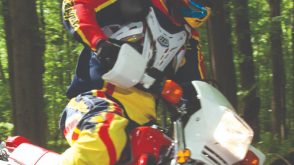
Chest protector
Chest protectors help shield your chest, shoulders and back against trail 'roost' kicked up by other riders. Available in a wide range of sizes - be sure to pick one that fits securely and comfortably.
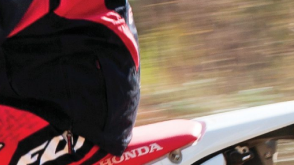
Kidney Belt
While not usually considered a mandatory piece of protective gear, kidney belts are still highly recommended. Designed for both lower back and kidney support while navigating rough terrain, it’s the smart choice to wear one every time you ride.
Step 3: Get out & play
You passed your licensing test with flying colours. You learned all about the different types of bikes and found the perfect one for you. Now the fun really begins! Before heading out on your first ride – in fact, before any time you ride - here are a few things to remember.
Take care of the unexpected
Before each ride, it’s important to inspect your motorcycle and make sure any problem you find is corrected. A careful pre-ride inspection and good maintenance are especially important, not only for safety, but because having a breakdown, or even a flat tire, can be a major inconvenience.
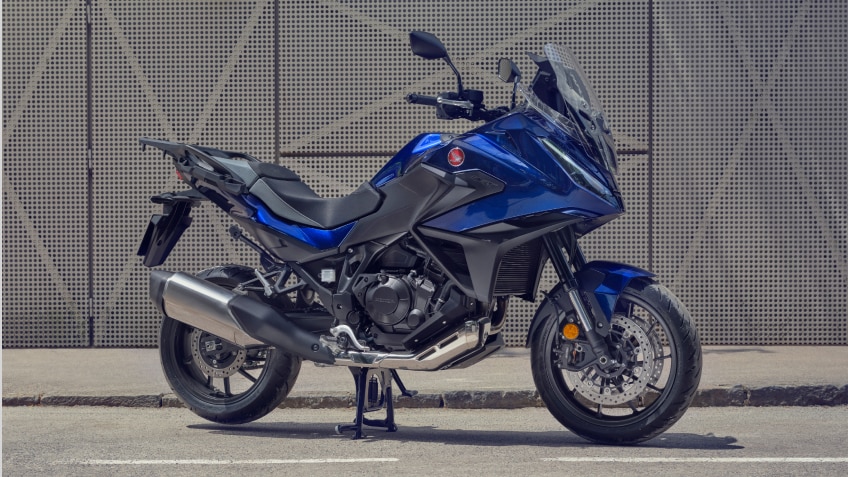
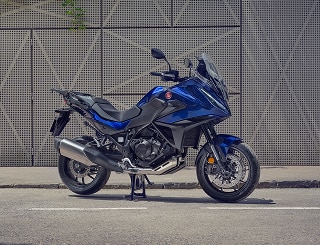
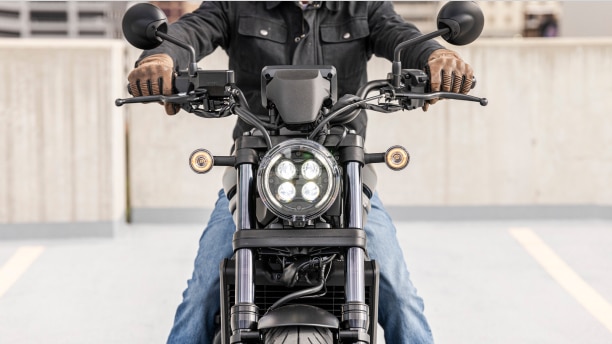
Preparing for a ride
A safe and enjoyable ride begins with good planning and preparation. Always ride with at least one other person in case you have troubles or let someone know where you’re going and when you expect to return.
Before riding, take time to get acquainted with your motorcycle and how it works. To protect your investment, we urge you to take responsibility for keeping your motorcycle well maintained.
Scheduled service is a must, of course, but it’s just as important to observe break-in guidelines and perform all pre-ride and other periodic checks detailed in your owner’s manual. We also recommend that you read your owner’s manual before you ride – it’s full of facts, instructions, safety information and helpful tips.
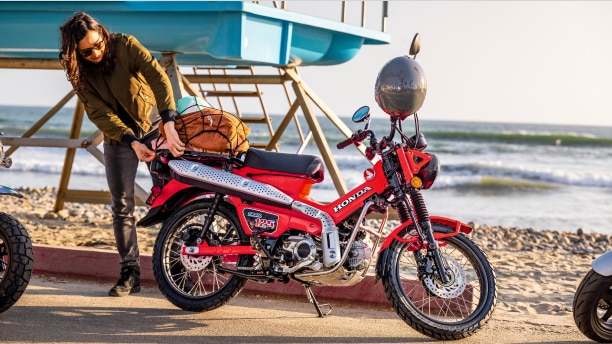
What to Take with you
What you take with you during a ride depends on how long you expect to ride, how far you might go and how experienced you or your companions are. We recommend that you always take water, a snack, a first aid kit and your owner’s manual. How much weight you put on your motorcycle, and how you load it, are important to your safety. Improperly loading your motorcycle can affect its stability and handling. Any time you ride with a passenger or cargo, you should adhere to the guidelines and other information in your owner’s manual. The weight of added accessories will reduce the maximum cargo weight you can carry. If you require more information on the cargo you can carry on your motorcycle, speak to your Honda dealer.
Pre-ride inspection
For your safety, it is very important to take a few moments before each ride to walk around your motorcycle and check its condition. If you detect any problem; be sure you take care of it, or have it corrected by your Honda dealer.
Check the levels of engine oil, fuel and coolant, and look for leaks.
Check the condition and the pressure of the tires.
Check the throttle for smooth opening and full closing in all steering positions.
Check that the engine stop switch works properly.
Check the operation of the front and rear brakes and make sure there is no brake fluid leakage.
Check the condition and amount of slack in the drive chain.
Check that the headlight, tail/brake light, turn signals, and horn function properly.
Check that the engine shuts off when the side stand is deployed.
For more information, refer to your owner’s manual and speak to your local Honda dealer.
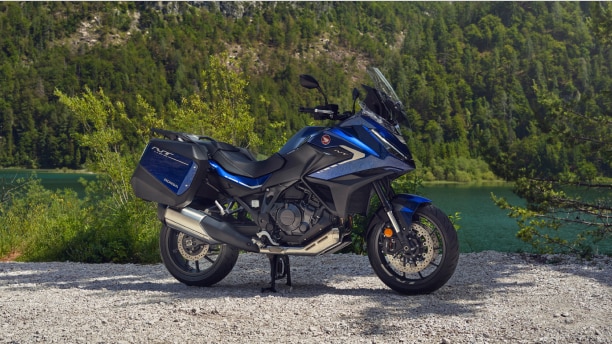
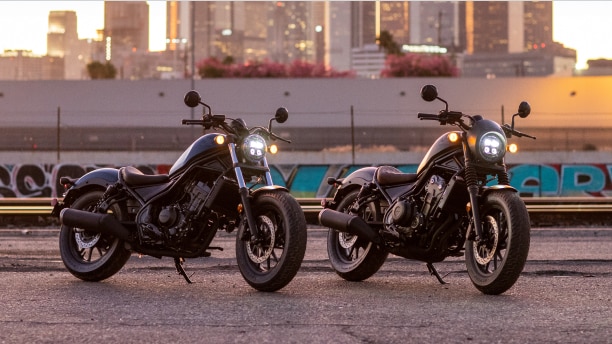
*Receive $200 towards the purchase of a new, previously unregistered Honda motorcycle before taxes. Offer available only to graduates of a Honda Canada approved motorcycle school in Canada. Graduates must have successfully completed the accredited Canadian program within the last 12 months to qualify. Offer can be combined with other current offers. View a complete list of participating Honda Canada approved motorcycle schools in the “Find a Honda Recommended Training School” section on the page above. Proof of graduation from an approved motorcycle school in Canada must be provided at time of redemption. Unauthorized reproduction of this coupon is unlawful. Limit one per graduate. Errors and omissions excepted. Honda Canada reserves the right to cancel, change program at any time without notice. Offer expires one year after graduation date.